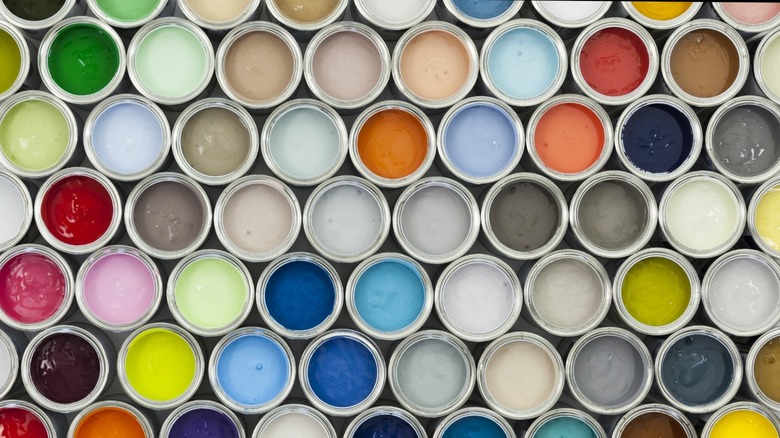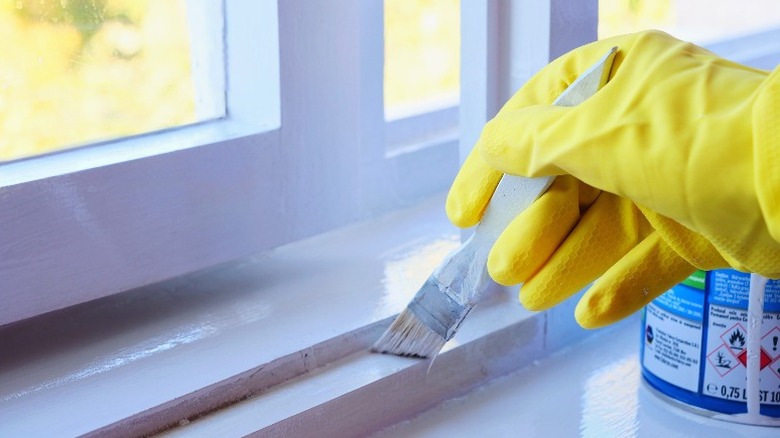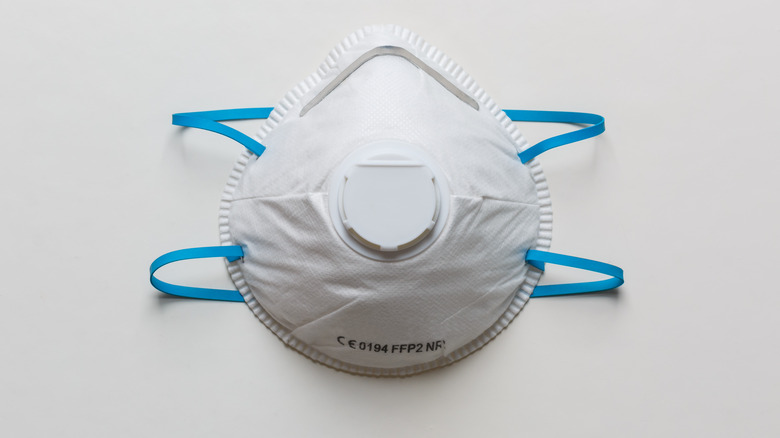What Is Enamel Paint And When Do You Use It?
Many homeowners look forward to the chance to improve their living space. In addition to the increased monetary value, there's also a sense of excitement and personal satisfaction that follows the completion of a DIY project. Painting is a great way to update your home, allowing you to create an impactful change for relatively little cost. According to a poll conducted by Sherwin-Williams in April 2021, as many as 56% of all homeowners intend to start a painting project sometime over the next year.
The first step in tackling a new painting project is educating yourself. Luckily, you've stumbled onto this guide that covers the basics of enamel paint, how to use it, and situations where it may be necessary. There are several important factors to be aware of, from safety precautions to disposal and every step in-between. A new project can be intimidating, but even a novice can succeed with the right tools and knowledge. If you've ever painted your nails, you've already used enamel paint. Read on to learn how to best prepare for your project, and find out if you should be using enamel paint.
What is enamel paint?
Generally, enamel paint refers to durable paint that air dries to a hard, glossy finish. Most formulas can withstand high levels of use, abrasion, moisture, high temperatures, and frequent cleanings. Traditionally, enamel paints are oil-based, but manufacturers have developed water-based enamels in more recent times.
The term enamel also refers to an opaque, glassy coating baked onto metal or ceramic objects. This is not the same as enamel paint, but the name was given to highlight their similar characteristics for marketing purposes. According to The Spruce, the earliest consumers of enamel paints trusted the new product's promise of strength and water resistance, as they were already familiar with baked-enamel porcelain and ceramic surfaces that were proven to be durable. Baked enamel is generally stronger, but enamel paint has the advantage of air-drying rather than requiring kiln-firing to cure. This gives it a greater range of useful applications, especially in DIY situations the average homeowner may take on.
Enamel paints are slightly more expensive than other formulas, but like latex paints, they are available at varying price points. They come in paint cans or as spray paint, and you can choose from several different brands depending on your preferences and needs. Best of all, they can also be found at your local hardware store, where someone will be available to answer any questions you might have.
Types of enamel paint
Enamel paints have historically been referred to as oil-based formulas, but water-based enamel paints have been developed more recently and are better suited for certain situations. The difference between oil-based and water based-enamel paints lies in the type of solvent present. According to Kraudelt Painting, oil-based enamels contain alkyd resin or mineral turpentine, whereas water-based formulas are primarily made up of water, as their name implies. The solvent evaporates as the paint dries, and the different physical and chemical changes produce different finishes and characteristics.
Oil-based enamels are primarily chosen for their excellent durability. Depending on the formula, the wet paint dries to a hard, rigid shell with a glossy finish over eight to 24 hours. The finish may slowly yellow as it oxidizes or lose its sheen over time. Oil-based enamel paints have a strong smell, are flammable, and contain toxic fumes that can harm your health if you do not follow recommended safety precautions, per Hunker. They also require chemicals such as paint thinner to be removed and must be disposed of according to hazardous waste guidelines.
By comparison, water-based enamels are objectively safer for both humans and the natural environment. Many have been developed to contain no VOCs, have a less intense odor, and require less extreme precautions and disposal methods. Water-based formulas are not as glossy, but will better retain their original sheen as they age. Water-based enamels are less durable than oil-based enamels, but have greater flexibility to accommodate material fluctuations. These stark differences help make clear which type of formula is better for your particular project.
How to use enamel paint
We've covered what enamel paint is, but how do you use it? Enamel paints can be applied in a couple of ways. In some cases, it's better to use a paintbrush, whereas a paint sprayer will be more efficient for covering large areas. The best bet is to follow the instructions included on the product label pertaining to application methods, safety precautions, and the time the formula will take to dry.
Enamel paint will adhere to almost any type of material, including wood, metal, rubbers, glass, and even other layers of paint, per Home Stratosphere. For all projects, you'll need to prep by thoroughly cleaning the surface you intend to paint. Depending on the material, you may also need to sand the surface to a smooth finish. These are the best ways to avoid any surface marks or defects that you will not be able to correct once you begin applying the paint. This is also the time to make sure the surface you are painting is completely dry. Otherwise, the paint will have trouble properly adhering.
Before painting, you'll need to put on safety equipment such as a paint respirator, gloves, and eye protection. It's also a good idea to cover the floor or surrounding surfaces you want to keep dry, especially if you attempt this type of project for the first time. If applying the paint with a brush, you'll need one with natural bristles, made explicitly for using enamel paint. The bristles on a sub-par brush can leave marks visible even after the paint has fully dried. DoItYourself strongly recommends applying the paint in a series of thin coats. This method will require more coats and thus more time spent painting, but it's worth it to make sure the paint cures correctly into a hard, durable finish. Make sure each coat has adequate time to dry before you apply another over it. The paint may appear dry on the surface before the inside is fully cured, so refer to the product label for drying information.
When to use enamel paint
Enamel paint has properties differing from latex or acrylic paint, making it a better choice for certain projects. Because it dries to form a rigid shell, it is most appropriate for materials that also remain rigid. For example, House Stratosphere explains that enamel paint is not recommended for house exteriors or other surfaces that expand and contract over time. Instead, latex or acrylic formulas are used for their flexibility. Here are some examples of situations when you may use enamel paint.
Enamel paint is a great choice for door casings, window sills, and cabinetry. The Craftsman Blog explains that the glossy finish avoids the issue of "blocking," which can occur when two painted surfaces come in contact and stick together. Enamel paint has none of the tackiness that you may experience if you use a latex or acrylic formula. If you're planning to update your space by painting your floor, an enamel formula is the way to go. Enamel paint is durable enough to withstand frequent use in high-traffic areas, and the easy-to-clean surface will help you keep your space presentable and sanitary.
For surfaces that reach high temperatures, enamel paint remains unaffected and will provide excellent protection. You can use it to repaint an aging outdoor grill or touch up indoor kitchen appliances. The enamel paint will also help prevent the metal from rusting, especially in high-humidity environments. Enamel paint can also be used to refurbish your outdoor furniture (via Home Decor Bliss). After several changing seasons and exposure to the elements, the finish on your outdoor furniture may have faded or chipped. Refresh your outdoor space with a new coat of enamel paint that will resist damage from harsh weather, moisture, and UV rays.
Is enamel paint safe?
Oil-based enamel paints contain VOCs, or volatile organic compounds. These are chemicals with strong odors that can be harmful to your health. VOCs are toxic to all individuals but pose a greater risk to vulnerable groups, including children, pregnant people, and the elderly.
For those who work with enamel paint regularly, long-term, repeated exposure can cause toxic chemicals to build up in the body. Eventually, this can result in damage to essential organs and the nervous system, according to the Environmental Protection Agency. Thankfully, the risk is minimal if proper precautions are taken, and warnings and instructions are included on the product label. Only use enamel paints when working in a well-ventilated area, and take regular breaks from your workstation. It's best to wear a paint respirator to reduce the risk of solvent inhalation, which can irritate or damage the lungs. Be sure also to wear gloves and appropriate clothing to avoid skin irritation. Wearing eye protection is also a good idea, especially when using aerosols. During and after working with enamel paint, keep your painting supplies as separate as possible from living spaces. It's best to discard enamel paint when not in use, but any that is saved must be properly stored. Keep enamel paint and related supplies in a well-ventilated area with minimal temperature fluctuations, where they are inaccessible to children and pets. Check to make sure all containers are adequately sealed to eliminate possible gas leaks.
Due to their flammability and toxic chemicals, unwanted or leftover oil-based paints are considered hazardous waste and cannot simply be thrown in the trash. Environmental protection laws stipulate that they must be disposed of at a hazardous waste center, according to Realtor. Find a local facility in your area, or dispose at a paint drop-off center that takes oil-based paints.





